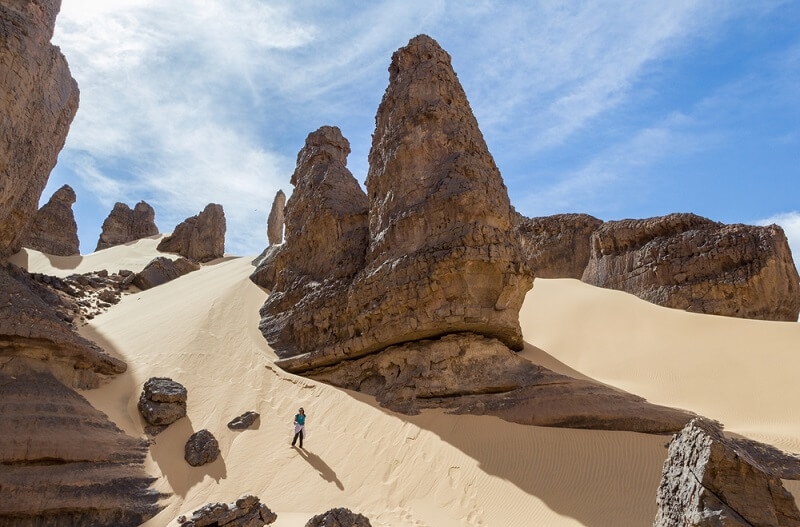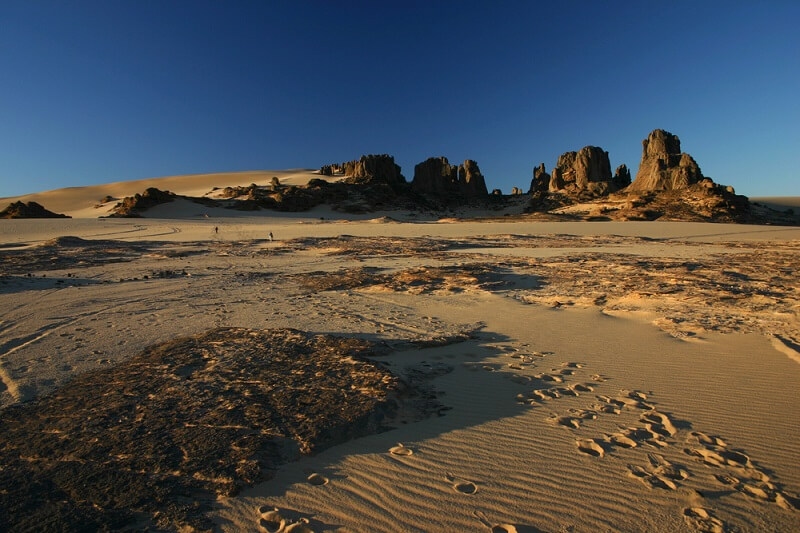
In the middle of the Sahara, far away from the noise of any modern city, lies a stretch of land that feels like another planet. Jagged peaks, endless sand, and a silence so deep it hums in your ears. This is the Ahaggar mountains—Algeria’s mysterious heart—and the home of one of the most underrated adventures in North Africa: Hoggar trekking.
It’s not the sort of trip you just stumble into. You plan it. You daydream about it. You build courage for it. And then, somewhere between sunrise and starlight, it changes the way you see the world.
Hoggar trekking isn’t about ticking off a tourist checklist. It’s about endurance, humility, and a strange sense of peace that creeps in once you’ve been walking for days. The terrain is raw—ridges rise out of nowhere, sand dunes melt into rocky plains, and the horizon always seems to run a little farther than you think.
Some trails lead past towering granite spires. Others curve into open plateaus where the light hits the earth in strange, holy ways. The air tastes dry and metallic. Every step feels like it matters.
You carry everything you need: water, food, a sleeping mat. The desert doesn’t hand out comfort. It rewards patience.
Every great story here begins in Tamanrasset. It’s a small, sun-washed town tucked deep in southern Algeria. At first glance, it looks like a mirage—low white buildings, date palms, motorbikes weaving through dusty streets. But stay a few hours and it grows on you.
Tamanrasset travel is a chapter of its own. The markets smell of spices and roasted meat. Locals in flowing blue robes—Tuareg people—move with calm dignity. They’ve lived here for generations, guiding travelers through a land most outsiders could never navigate alone.
Most treks begin here. Permits are sorted, supplies bought, routes mapped. Then comes the quiet moment before departure, when you look out toward the desert and realize how far you’re about to go.
At the center of this landscape stands Mount Tahat, the tallest peak in Algeria. The Mount Tahat hike draws climbers and dreamers alike—not because it’s the hardest, but because it’s the most spiritual. The climb begins from the Assekrem plateau, where Charles de Foucauld, a French hermit and scholar, once built his stone hermitage.
The path winds upward through ridges of black rock. The air gets thinner. Nights drop cold. Then finally, near dawn, you reach the top. Below you, the Sahara rolls out like a golden ocean.
When the sun rises, it paints the Ahaggar mountains in orange and pink. There’s no sound except the wind. It’s not triumph that fills you—it’s gratitude. Standing there, every worry you carried from the city feels smaller. That’s the power of the mountain.

The desert mountain trails of the Hoggar are a lesson in rhythm. Step, breathe, step. The land teaches patience. It changes with every hour—morning light turns the rocks soft and silver, noon burns them copper, dusk cools them into deep indigo.
You’ll pass herds of camels grazing in dry wadis, and sometimes, a nomad tent made of woven goat hair, flapping softly in the wind. The Tuareg guides move ahead like ghosts, quiet and sure-footed. They know every stone, every direction by instinct.
At night, fires flicker in the sand. Someone pours mint tea. The stars above are so bright they almost look fake. You sit there, wrapped in a blanket, sipping warmth, listening to the quiet hiss of wind.
If peace had a sound, it would sound like this.
The southern Algeria hikes are more than just adventure—they’re immersion. Each trail crosses land that’s still alive with memory. Thousands of years ago, this part of the Sahara wasn’t desert at all. Cave paintings hidden in rock shelters show hunters, giraffes, even rivers. Life flourished here long before the sand took over.
Tuareg culture keeps that connection alive. Guides share stories of ancestors who walked these same paths with camel caravans, trading salt and spices between distant oases. Around the fire, their voices blend with the crackling wood and the low whistle of the wind.
You start to realize that this isn’t just geography—it’s heritage. Every dune, every rock, has a story to tell if you slow down enough to listen.
Few places capture the soul of the Hoggar like Assekrem. It’s a plateau high above the desert, about 2,700 meters up, where the sky feels close enough to touch. It’s quiet up here—so quiet you can hear your heartbeat.
Charles de Foucauld’s hermitage still stands, small and humble against the vast backdrop of stone. Monks live there, carrying on his legacy of contemplation and peace. Travelers who visit often stay overnight to catch the sunrise, and once you’ve seen it, you understand why.
The first light spills over the desert mountain trails, and the peaks glow like molten metal. Shadows stretch long and slow. The silence is total. Even the wind seems to pause in respect.
It’s one of those rare places where you feel time stop—where nothing else matters but the moment itself.
Before setting out, every traveler needs to know a few simple truths about Hoggar trekking.
The best time to go is between October and March. During these months, the desert is kinder. Days hover around 20°C, nights can get cold enough for gloves and wool hats. Summer, on the other hand, is punishing—temperatures often cross 45°C.
Guides are essential. They know where to find water, how to navigate storms, and how to read the land’s subtle signs. Most travelers hire Tuareg guides in Tamanrasset, supporting local families while ensuring safety.
Pack light but smart: solid boots, layered clothing, sunscreen, a hat, a sleeping bag, and enough water to last between stops. And bring respect—for the land, for the people, for the silence.
After a few days, something changes. You stop checking your watch. You forget about deadlines, phones, and screens. Life simplifies into one goal—walk, breathe, rest, repeat.
The desert humbles you. You realize how small humans are in the face of nature’s vastness. You also realize how much noise fills your daily life back home. Out here, even thoughts sound clearer.
On long southern Algeria hikes, people often describe strange clarity. The kind that comes from being completely disconnected and yet more connected than ever—to yourself, to the world around you, to something much larger and older.
There’s a kind of magic that happens after sunset. The temperature drops, the sand cools, and the stars take over the sky. No city lights, no noise, no filters—just raw, glittering infinity.
You might find yourself lying on your back, tracing constellations, listening to a guide hum a song older than any country. The Milky Way stretches across the horizon like a frozen river. You breathe slower. You think less. You just are.
Moments like that stay. Long after you’ve flown home, unpacked, and moved on, they come back when you least expect it—a smell, a breeze, a certain light in the sky—and suddenly you’re back under those stars again.
Trekking here comes with a duty. The Ahaggar mountains are ancient but fragile. Travelers are urged to follow the leave-no-trace rule—no litter, no graffiti, no souvenirs chipped from stone. Respecting the desert isn’t a guideline here; it’s survival.
Local guides take pride in protecting their homeland. Choosing local operators, eating their food, and buying their crafts helps sustain both culture and nature. Every small act counts.
In the Hoggar, gratitude isn’t spoken—it’s shown.
The funny thing about the desert is that you leave it, but it doesn’t leave you. You might come back to your city apartment, but something inside feels slower, steadier. You find comfort in silence. You start noticing how the sky looks before dawn.
That’s the real gift of Hoggar trekking. It strips away all the unnecessary noise until you’re left with only what matters. A sunrise. A trail. The steady rhythm of your breath.
You don’t conquer the desert—you let it reshape you.
For some, it’s just a hike. For others, it’s a quiet kind of awakening. And once you’ve seen the sun rise over Mount Tahat, glowing like fire over the endless sand, you understand what every traveler says when they come back: you never really leave the Hoggar. It stays with you.
This content was created by AI